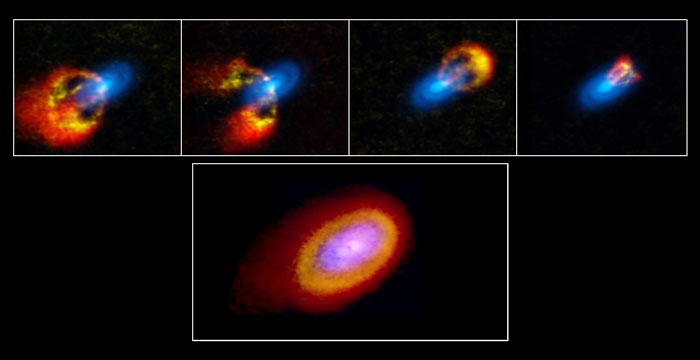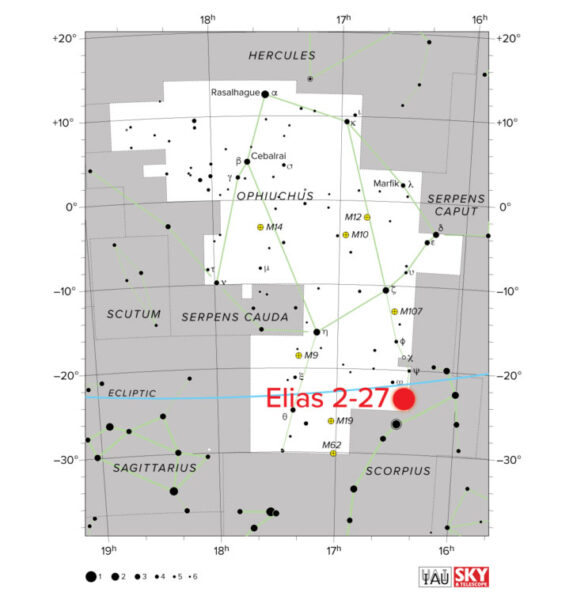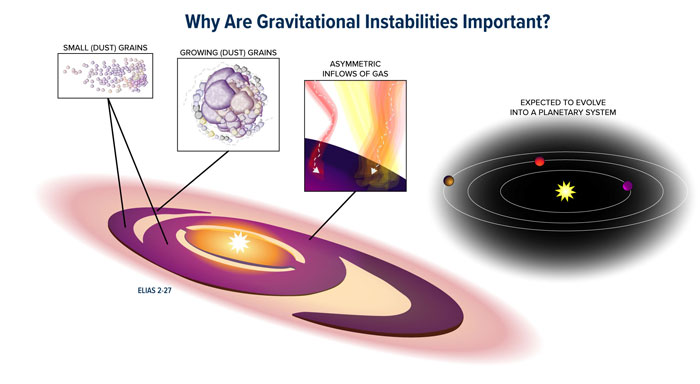Astronomers investigate the spiral arms of a young star’s disk and find evidence of a disk so massive that it could collapse to form planets.

ALMA (ESO/NAOJ/NRAO)/T. Paneque-Carreño (Universidad de Chile), B. Saxton (NRAO)
Astronomers have found the first signposts of a gravitationally unstable disk around the young star Elias 2-27 — the first evidence to support this method of giant planet formation.
Protoplanetary disks of gas and dust leftover from stellar formation are known as the birthplace of planets. Astronomers understand that these disks give way to planets, but they’re still working to determine the exact evolution from dust to new worlds.
There’s more than one way to form a planet, and one path might be gravitational instability – when disks become so massive that they begin to fragment and cave in on themselves, directly collapsing into planets or forming spiral arms that trap material for future planet formation. An already-formed giant planet or interactions with a nearby star can also create spirals, but spiral structure born out of gravitational instability carries special characteristics.
A team led by Cassandra Hall (University of Georgia) was the first to predict what the markers of gravitational instability might look like. Hall and collaborators used simulations to determine the telltale sign of gravitational instability in a disk, affectionately dubbed the “wiggle.” This wiggle disturbs the disk’s rotation on scales coinciding with the spirals, instead of in one specific location like the swirling kinks caused by planets.

In 2016, scientists at the Atacama Large Millimeter/submillimeter Array (ALMA) first saw spiral arms in the disk of Elias 2-27. Now, research led by Teresa Paneque-Carreño (now at University of Leiden, The Netherlands), has spotted the hallmark wiggle. The finding makes these spiral arms the first convincing evidence for a gravitationally unstable disk. This study will appear in the Astrophysical Journal.
Evidence for Instability
With Hall’s predictions in mind, Paneque-Carreño’s collaboration used ALMA to observe the dust and gas in Elias 2-27’s disk. The results show that the expansive spiral arms are symmetric, with similar shapes and sizes, as predicted if gravitational instability were at work.
The key piece of evidence for instability, however, is the wiggle. The team used ALMA to observe the motions of carbon monoxide – which traces the harder-to-observe, but more abundant, hydrogen gas – and discovered the sought-after signature. As predicted, this disturbance coincides with the spiral arms in most observations. “It is really amazing to see this confirmation of velocity perturbations that so closely resembles what was predicted,” Hall says, who also worked on the Elias 2-27 studies.

ALMA (ESO/NAOJ/NRAO)/T. Paneque-Carreño (Universidad de Chile), B. Saxton (NRAO)
These signals of gravitational instability also led to the first direct measurement of the mass in a planet-forming disk. Using the ALMA data, collaborator Benedetta Veronesi (University of Milan, Italy) reported the mass in a companion study that will appear in Astrophysical Journal Letters. Veronesi’s team concluded that Elias 2-27’s disk has 17% the mass of its star, creating conditions ripe for gravitational instabilities. In thinner disks, the star calls the shots with its powerful gravity governing the motions of the disk. But for a massive disk like the one around Elias 2-27, the disk’s own gravity starts to influence its dynamics, which enabled Veronesi’s team to determine its mass budget for future planet formation.
Oddities of Elias 2-27
While the spiral, wiggle, and mass all indicate the disk is experiencing gravitational instability, gaps in that same disk are throwing astronomers for a loop. For instance, there is a gap in the middle of the disk that is devoid of dust – a trait typically attributed to the commotion of a forming planet. However, a planet forming a gap of this size wouldn’t be large enough to form the spiral structure. Even if there were a planet at this location, it would get sucked into the star. On the other hand, gravitational instability cannot explain the gap, even though it explains the spirals.
While neither phenomenon can explain both features, the evidence for gravitational instability is still valid, says Ken Rice (University of Edinburgh), who was not involved in the study. “I don't think the presence of a gap necessarily suggests that spirals aren't being driven by the gravitational instability.”

ALMA (ESO/NAOJ/NRAO)/T. Paneque-Carreño (Universidad de Chile), B. Saxton (NRAO)
Paneque-Carreño’s team also finds that the gas in Elias 2-27’s disk is unexpectedly asymmetric, such that the gas is thicker on one side of the disk than the other. The varying layers of gas indicate that material could still be falling onto the disk from the cloud that formed the Elias 2-27 system. This inbound gas might have ignited the gravitational instability and even caused a disk warp that morphed into the currently observed dust gap.
Although more observations are needed to solve the conundrums of Elias 2-27’s disk, the evidence for a massive, gravitationally unstable disk is quite compelling, says Rice.
Astronomers still need to work out how gravitational instability leads to planets — via direct collapse or indirectly, inciting spiral structures that help funnel material. Elias 2-27 and others like it will help astronomers piece together the planet formation puzzle.
 1
1









Comments
hoopydirtbag
July 18, 2021 at 7:57 pm
Whoever is making the algorithms for planetary accretion may profit from a visit to hisers local amusement park and spend an hour or so at the spun candy booth !
You must be logged in to post a comment.
You must be logged in to post a comment.